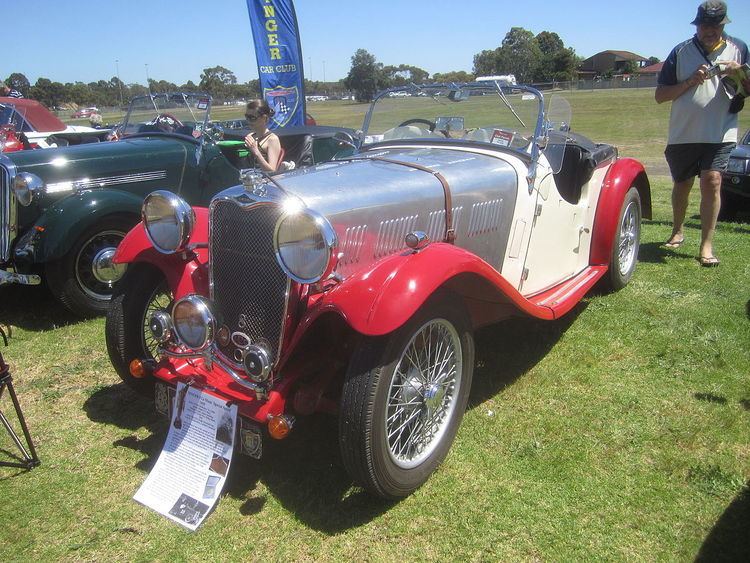Production 1932–1937 Engine 972 cc OHC I4 | Layout FR layout | |
 | ||
Manufacturer Singer & Co Limited then Singer Motors Limited Assembly Birmingham and Coventry England Body style 2/4-door saloon
2/4-seat sports tourer
2-seat sports car | ||
The Singer Nine is a car which was produced by Singer Motors Limited from February 1932 to 1937, and then again from 1939 until 1949 as a Roadster only. It was offered as a new economy model, replacing the earlier Singer Junior series.
Contents
The Singer Nine saloon was replaced by the shorter Bantam Singer Nine in 1936. The sports models were not replaced until 1939 by the Bantam-based tourer, Nine Roadster.
History
The Nine has a 972 cc overhead cam engine, based on the 848 cc engine seen in the 8HP Junior. This variation had already been introduced in the Junior Special, a short-lived interim model shown at the 1931 Olympia Motor Show four months before the Nine's introduction. Power output is 26.5 hp (19.8 kW). Power transmission was through a four-speed manual gearbox.
Nine Sports and variants
A four-seat tourer model with abbreviated fenders and no running boards called the "Nine Sports" was also made from October 1932, and one of these managed to finish thirteenth at the 1933 24 Hours of Le Mans race. In 1933, celebrating this moderate success, a new underslung racy two-seat model called the Singer Le Mans appeared. With twin SU carburetors, the Sports offered 31 hp (23 kW) at 4600 rpm, providing a 66 mph (106 km/h) with the wind screen down - impressive for the era and at a price considerably lower than the competition. The Nine Sports was also used in various other endurance races, finishing second in class in the Alpine 6-days trial (Coupe Internationale des Alpes) in 1933.
For 1934 the front fenders were elongated to protect the paintwork on the sides of the car, as the earlier short units were found wanting. For 1935, as the sportier Le Mans gained a four-seater option, running boards appeared on the Nine Sports along with larger doors and a curvier rear end. In 1936, the shorter and simpler Nine-engined Bantam Nine appeared, and in 1937 the Nine was discontinued in favor of this model. However, in 1939 the "Nine" name reappeared on a new Roadster model which depended heavily on the Bantam, meaning that the Nine was to continue in production until into 1949, and as the 4A/4AB until 1953.
Le Mans
The Le Mans had a higher tuned version of the 972 cc inline-four, with higher camshafts, bigger and better cooled oil sump, and a counterbalanced crankshaft. Power climbed to 34 hp (25 kW) and a close-ratio gearbox was fitted. The frame was dropped behind the front wheels and thus underslung at the rear. No running boards, a 12-imperial-gallon (55 L) external fuel tank and twin spare tyres finished the competition appearance. As opposed to the competing MGs, the Singer had more powerful and dependable hydraulic Lockheed brakes. The Nine Le Mans, while not particularly successful at the track which gave it its name, clocked up an impressive number of wins at hillclimbs, trials, and various endurance races such as the Liège-Rome-Liège and the Alpine Cup Rally. In 1935 a four-seater version of the Le Mans was also available, somewhat of a hybrid of the Sports and the regular Le Mans.
Special Speed
Also for 1935, the more spacious and powerful Special Speed version appeared. This had running boards, a bigger 13.5-imperial-gallon (61 L) fuel tank, and a bigger passenger compartment achieved by moving the spare wheels backwards. The Special Speed also received a tuned 38 hp (28 kW) engine with twin horizontal SU's, bigger valves, higher cams, and higher compression. For 1936 and 1937, the Special Speed replaced the Le Mans model.
Le Mans Replica
In 1935, Singer added a Le Mans Replica to their catalogue. At more than twice the price of a regular Le Mans, this was intended for an uncompromising owner. In the end, however, only four of these highly tuned lightweight specials were built, and all remained with Singer until after the 1939 racing season. One of these finished as the first one-litre car at the 1935 Le Mans (second in the 1.1 class). The Replica also saw action at Brooklands and at the Donington and Ulster Tourist Trophies. The replica has a 10:1 compression ratio and various other engine modifications, which coupled with its streamlined part-alloy bodywork meant a top speed of over 90 mph (140 km/h). The 1,288 lb (584 kg) weight was 425 lb (193 kg) less than that of a regular Le Mans two-seater. The correct designation is Works Team Car and they were intended for the TT race. Three of the four cars made, ran in the 1935 Le Mans race. In order to be used in the TT race they had to be production models and were advertised as ‘replicas’ of the cars that ran at Le Mans. No more cars were made.
Roadster
The Roadster was a variant of the Bantam Singer Nine. After some years Singer cautiously returned to the sports tourer but not sports car market. The open four-seater Nine Roadster appeared 6 March 1939 with a lightly tuned version of the larger 1074 cc overhead camshaft engine already seen in the Bantam Nine, as well as that car's three-speed gearbox.
